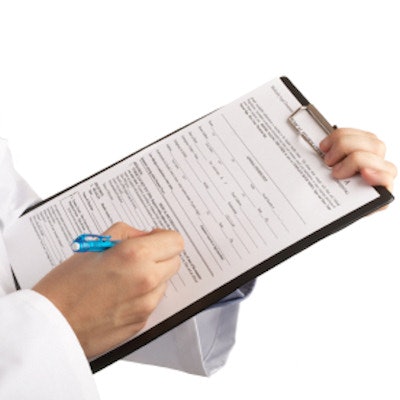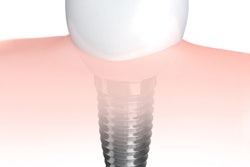
Peri-implant tissue quality has typically been evaluated in a binary fashion -- either an implant is failing or it's not. But a method that focuses on peri-implant tissue stability and detects early signs of deterioration would be useful for practitioners. Enter the peri-implant tissue score (PITS), a long-term monitoring tool designed for use in general dental practices that combines measurements of five parameters.
Researchers reported on their development of the tissue score, a system for identifying successful and failing implants, as well as a third category of implants: ones that are surviving and capable of improvement with timely intervention (Quintessence International, May 17, 2018). They also included results of testing their system in 889 retrospectively identified implants placed in 293 patients.
"PITS gives clinicians a tool for relatively fast assessment of the state and prognosis of an individual implant," wrote the authors, led by Zbyněk Mazur, MUDr, a dental surgeon in Prague. "Furthermore, its components allow identification of the weak points (via parameters with low scores) and help the subsequent decision-making about conservative or surgical treatment to address those issues and to improve the implant's prognosis."
Keeping score
Various techniques can assess aspects of implant success and long-term stability, but none has evaluated tissue stability independently beyond denoting success or lack thereof, the authors noted. Identification of reliable signs of early changes preceding the loss of osseointegration could help with choosing appropriate and timely treatment, they wrote.
“PITS gives clinicians a tool for relatively fast assessment of the state and prognosis of an individual implant.”
Therefore, the researchers sought to create a method for classifying the gray area of implants that are surviving yet imperfect and those that are still successful that would accomplish the following:
- Identify optimal clinical parameters for providing a monitoring and evaluation system for assessing implant stability.
- Provide a comprehensive and easy-to-use scoring system that offers early warning of deteriorating peri-implant tissue.
- Monitor implant tissue stability, allow for reversibility of tissue state, and be usable in general dental practices.
They achieved this by basing the peri-implant tissue score on five observable variables considered relevant by implant dentistry experts: bone, inflammation, mucosa, recession, and profile.
Each parameter was scored on a three-grade scale from 0 (the lowest) to 2, with the total score ranging from 0 and 10 and based on the sum of the five elements. The gray area between a desirable state (grade 2) and dissatisfactory state (grade 0) was assigned grade 1.
| Peri-implant tissue score parameters | |||
| Parameter | Value 0 | Value 1 | Value 2 |
| Bone | Progressive bone loss: crestal bone loss ≥ 3 mm or greater | Moderate bone loss: crestal bone loss of 1 to 3 mm | Stable: crestal bone loss < 1 mm |
| Inflammation | Peri-implantitis | Mucositis | Healthy soft tissues |
| Mucosa | Width of attached mucosa < 1 mm when only free mucosal margin or junction epithelium is present | Width of attached mucosa 1 to 3 mm when connective tissue attachment is present | Width of attached mucosa ≥ 3 mm when the periosteal attachment is present |
| Recession | Visible intraosseal part of an implant | Visible mucosal margin of an implant/abutment | Implant margin not visible |
| Profile | Concave compared with surrounding tissue | Flat, horizontally narrower than in natural teeth | Convex, corresponding to natural teeth |
The researchers evaluated bone presence around an implant using radiography. For bone-level implants, they measured crestal bone loss as the distance between the interface and the first bone-to-implant contact point. If the contact point was different on the mesial and distal sides of the implant, they used the longer distance.
For grading inflammation, the researchers diagnosed mucositis if the following was present:
- Dental plaque
- Bleeding on gentle probing without suppuration
- Probing depth 3 to 4 mm
- Crestal bone resorption less than 2 mm
They diagnosed peri-implantitis in the following situations:
- Probing depth of 5 mm or more
- Presence of suppuration
- Progressive crestal bone loss, often in crater-like formation
For grading mucosa, they considered the width of attached mucosa as the difference between the width of the whole keratinized mucosa and the probing pocket depth, with all negative values considered as 0 mm.
After developing PITS, the group used it to analyze the results of 293 patients treated with 889 implants with airborne-particle acid-etched surfaces in Dr. Mazur's practice over an 11-year period. For the current study, the investigators examined participants clinically and with imaging.
The patients lost 20 of the original implants, nine before and 11 after loading. The investigators identified 42 implants that were not successful, 17 because of onsite peri-implantitis and 25 due to other causes; PITS was 3.02 ± 1.62 among them. In the 828 successful implants, PITS was 7.76 ± 1.59. The length of time since implantation did not relate to the score.
The investigators found the following trends in the PITS values:
- A score of 8 through 10 indicated stable implants with excellent prospects for remaining successful.
- A score of 6 and 7 in successful implants often indicated reduced inflammation or bone grades but with a less than optimal prognosis for continued success.
- A score of 4 through 7 should prompt consideration of danger signs and steps should be taken to counter these signs.
- A score of 5 and lower indicated intervention is needed in most cases to prevent impending implant loss.
Looks not considered
The authors noted that they did not consider the aesthetic aspects of implants since this did not affect the long-term stability of tissues around loaded implants. They emphasized that PITS can be used with bone- and tissue-level implants for long-term monitoring and requires only standard dental x-ray imaging and a graded probe.
"PITS helps to shift the success evaluation paradigm from binary and usually irreversible successful/nonsuccessful scores to a reversible score quantifying the 'degree' of success," the authors concluded.



















